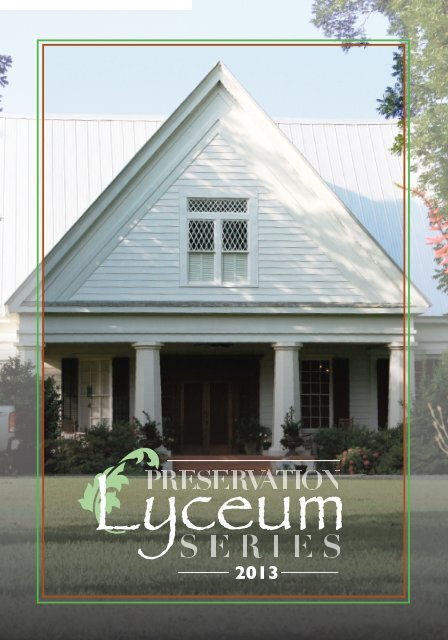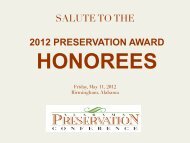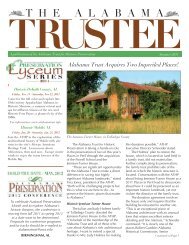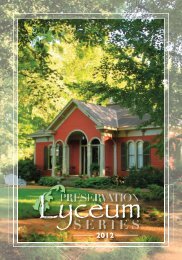here - Center for the Study of the Black Belt
here - Center for the Study of the Black Belt
here - Center for the Study of the Black Belt
Create successful ePaper yourself
Turn your PDF publications into a flip-book with our unique Google optimized e-Paper software.
'Lyceum<br />
2013
Preservation Lyceum Series<br />
Lyceum - (li-se-am), a place <strong>for</strong> public lectures, debates, classes, concerts and entertainment.<br />
Join <strong>the</strong> Alabama Trust <strong>for</strong> Historic Preservation <strong>for</strong> <strong>the</strong> third season <strong>of</strong> <strong>the</strong> Preservation Lyceum Series,<br />
a set <strong>of</strong> quarterly programs <strong>for</strong> preservation-minded individuals who want to know more about and visit<br />
historic preservation projects.<br />
The 19th century Lyceum Movement that flourished in America provided hundreds <strong>of</strong> in<strong>for</strong>mal<br />
ga<strong>the</strong>rings <strong>for</strong> <strong>the</strong> purpose <strong>of</strong> improving <strong>the</strong> social and intellectual fabric <strong>of</strong> society. Characterized by<br />
lectures and public discourse on a variety <strong>of</strong> topics and musical and <strong>the</strong>atrical per<strong>for</strong>mances in a retreat<br />
environment, lyceums peaked during <strong>the</strong> Antebellum Era. With <strong>the</strong> exception <strong>of</strong> <strong>the</strong> New York Great<br />
Lake’s Chautauqua Institute, best known <strong>for</strong> <strong>the</strong> Chautauqua Symphony Orchestra, few remnants <strong>of</strong> this<br />
vibrant phenomenon remain on <strong>the</strong> national landscape.<br />
Drawing from <strong>the</strong> past, <strong>the</strong> Alabama Trust <strong>for</strong> Historic Preservation’s Preservation Lyceum Series travels<br />
<strong>the</strong> highways, byways and crossroads <strong>of</strong> Alabama exploring, experiencing and engaging in preservation.<br />
2013 SUMMER PRESERVATION LYCEUM<br />
The Antebellum Roots <strong>of</strong> Alabama’s <strong>Black</strong> <strong>Belt</strong><br />
Friday, August 2 – Saturday, August 3<br />
During <strong>the</strong> pre-territorial days <strong>of</strong> Alabama and long be<strong>for</strong>e statehood, Alabama’s <strong>Black</strong> <strong>Belt</strong> nurtured its<br />
native citizens and early settlers. This summer, <strong>the</strong> ATHP’s Lyceum tours Alabama’s historically and<br />
culturally-rich <strong>Black</strong> <strong>Belt</strong> to explore and study <strong>the</strong> region’s architecture and heritage.<br />
The 2013 Summer Preservation Lyceum Weekend begins in Livingston, <strong>the</strong> western end <strong>of</strong> a string <strong>of</strong><br />
antebellum pearls gracing <strong>the</strong> nor<strong>the</strong>rn edge <strong>of</strong> <strong>the</strong> <strong>Black</strong> <strong>Belt</strong> prairies, by exploring what is possible <strong>for</strong><br />
<strong>the</strong> restoration <strong>of</strong> historic churches and homes. A drive through <strong>the</strong> region’s prairie lands will end in<br />
gracious Greensboro, whose history features early pioneers, Alabama governors, Civil Rights leaders and<br />
<strong>the</strong> luminance <strong>of</strong> creative revitalization through historic preservation.<br />
Join <strong>the</strong> Alabama Trust <strong>for</strong> Historic Preservation <strong>for</strong> this Preservation Lyceum Weekend to see what<br />
small towns are doing to preserve and enhance some <strong>of</strong> <strong>the</strong> best <strong>of</strong> <strong>the</strong> <strong>Black</strong> <strong>Belt</strong>’s historic gemstones.<br />
2013 FALL PRESERVATION LYCEUM<br />
The Roots <strong>of</strong> Religious Architecture in Lee and Macon Counties<br />
Friday, November 1 – Saturday, November 2<br />
Auburn – Tuskegee<br />
Explore <strong>the</strong> preservation <strong>of</strong> Alabama’s scared spaces from cemeteries, to churches,<br />
to early revival campgrounds.<br />
Schedule and registration in<strong>for</strong>mation available mid-September.<br />
Front cover photograph courtesy <strong>of</strong> Drake – Northrup – Cherry House, Greensboro
SUMMER PRESERVATION LYCEUM<br />
Sponsored by <strong>the</strong><br />
Alabama Trust <strong>for</strong> Historic Preservation, City <strong>of</strong> York, Greensboro Area Business and Tourism<br />
Association, Hale County Historic Preservation Society,<br />
Sumter County Historical Society and <strong>the</strong> University <strong>of</strong> West Alabama.<br />
When<br />
Friday, August 2– Saturday, August 3<br />
W<strong>here</strong><br />
Livingston/Greensboro<br />
PROGRAM<br />
Friday Evening<br />
6:00 p.m. – 8:00 p.m.<br />
<strong>Black</strong> <strong>Belt</strong> Hospitality Energized – Cocktails and Dinner<br />
Prystup House<br />
Conti Street, York<br />
Revel in an evening <strong>of</strong> cocktails and dinner at <strong>the</strong> Prystup House (circa 1974). Described as “a composition<br />
<strong>of</strong> technology at work with its twin, Mo<strong>the</strong>r Nature,” <strong>the</strong> structure is a unique example <strong>of</strong> an early<br />
contemporary Alabama solar-energy home. Enjoy a rare, private tour <strong>of</strong> <strong>the</strong> Prystup House with owner<br />
Les Prystup and daughter, Suzanne P. McGahey. Attire: Dressy Casual.<br />
<strong>Black</strong> <strong>Belt</strong> Hospitality compliments <strong>of</strong> <strong>the</strong> Division <strong>of</strong> Educational Outreach-University <strong>of</strong> West Alabama, City <strong>of</strong> York<br />
and Sumter County Historical Society.<br />
Saturday Morning<br />
7:30 a.m. – 8:00 a.m.<br />
Registration and Check-In<br />
Student Union Drive, Land Hall, University <strong>of</strong> West Alabama campus, Livingston<br />
Select luncheon menu option at sign-in.<br />
Have a cup <strong>of</strong> c<strong>of</strong>fee with a briefing <strong>of</strong> <strong>the</strong> day’s schedule.<br />
C<strong>of</strong>fee courtesy <strong>of</strong> <strong>the</strong> Division <strong>of</strong> Educational Outreach-University <strong>of</strong> West Alabama.
8:00 a.m. – 8:45 a.m.<br />
History on <strong>the</strong> Move<br />
Student Union Drive, Land Hall, University <strong>of</strong> West Alabama campus, Livingston<br />
Walk through history with a tour <strong>of</strong> buildings relocated to <strong>the</strong> University campus by <strong>the</strong> <strong>Center</strong> <strong>for</strong> <strong>the</strong><br />
<strong>Study</strong> <strong>of</strong> <strong>the</strong> <strong>Black</strong> <strong>Belt</strong>. Tour includes historic structures from Hale and Sumter counties including <strong>the</strong><br />
Alamuchee-Bellamy Covered Bridge (circa 1861), Campbell House (circa 1900) and Cedarwood (circa<br />
1818). Learn how preservation can enrich <strong>the</strong> culture <strong>of</strong> a college campus, while serving as a learning<br />
laboratory <strong>for</strong> scholars and students. Tour Guides: Dr. Tina Jones, Dean <strong>of</strong> <strong>the</strong> Division <strong>of</strong> Educational<br />
Outreach, and Dr. Valerie Burnes, Director <strong>of</strong> <strong>the</strong> <strong>Center</strong> <strong>for</strong> <strong>the</strong> <strong>Study</strong> <strong>of</strong> <strong>the</strong> <strong>Black</strong> <strong>Belt</strong>, University <strong>of</strong> West<br />
Alabama.<br />
9:00 a.m. – 10:00 a.m.<br />
Ramble Through <strong>the</strong> <strong>Black</strong> <strong>Belt</strong><br />
Take <strong>the</strong> 48-mile scenic drive through <strong>the</strong> western <strong>Black</strong> <strong>Belt</strong> countryside from Livingston to Greensboro<br />
along Highways 11 and 14. Enjoy <strong>the</strong> best <strong>of</strong> geographical and historic vistas traveling through <strong>the</strong><br />
Tombigbee River Valley to quaint Boligee, once <strong>the</strong> center <strong>of</strong> <strong>the</strong> richest plantation region in <strong>the</strong> country,<br />
be<strong>for</strong>e heading across <strong>the</strong> prairie lands to Greensboro. See an abundance <strong>of</strong> waterfowl and raptors<br />
attracted to <strong>the</strong> region’s glistening catfish ponds. Slow down through Eutaw to see <strong>the</strong> newly restored<br />
courthouse square be<strong>for</strong>e crossing <strong>the</strong> <strong>Black</strong> Warrior River into Hale County and watch <strong>for</strong> <strong>the</strong><br />
geographical transition from prairie, to woodlands.<br />
See Lyceum registration packet <strong>for</strong> driving directions.<br />
10:00 a.m. – 11:00 a.m.<br />
Tour <strong>of</strong> Historic Greensboro Downtown<br />
Project Horseshoe Community Club House<br />
1310 Main Street<br />
A brief introduction to Greensboro highlights <strong>the</strong> town’s origins and current ef<strong>for</strong>ts to revitalize its historic<br />
downtown through preservation. Walk through Greensboro’s historic Main Street business district –<br />
designated as a historic district in <strong>the</strong> National Register <strong>of</strong> Historic Places. Visit recently restored and<br />
re-adapted historic commercial buildings and several ongoing projects. Tour includes <strong>the</strong> Project Horseshoe<br />
Community Clubhouse (circa 1890’s), HERObike (circa 1890’s), HERO Headquarters (1900); and <strong>the</strong><br />
Greensboro Opera House (1903). Tour Guide: Ashley Dumas, Greensboro resident and Pr<strong>of</strong>essor <strong>of</strong><br />
Archeology, University <strong>of</strong> West Alabama. Walking shoes recommended.<br />
www.greensborooperahouse.org
11:00 a.m. – 1:45 p.m.<br />
Lunch<br />
Newbern Mercantile Company<br />
7780 Highway 61, Newbern<br />
8 miles south <strong>of</strong> Greensboro<br />
Lunch at <strong>the</strong> historic Newbern Mercantile (1900), followed by a short driving tour <strong>of</strong> historic Newbern’s<br />
antebellum churches and Chantilly (circa 1850s), an unusual historic home being renovated by Auburn<br />
University’s architectural students studying at <strong>the</strong> Rural Studio. Funding <strong>for</strong> <strong>the</strong> renovation is provided in part<br />
by <strong>the</strong> Alabama Historical Commission.<br />
Saturday Afternoon<br />
2:00 p.m. – 3:00 p.m.<br />
Safe House Museum<br />
2401 Davis Street, Greensboro<br />
During <strong>the</strong> night <strong>of</strong> March 21, 1968, <strong>the</strong> Reverend Dr. Martin Lu<strong>the</strong>r King, Jr. took refuge from <strong>the</strong> Ku Klux<br />
Klan with <strong>the</strong> Burroughs, a local family residing in <strong>the</strong> (now historic) Depot Neighborhood <strong>of</strong> Greensboro.<br />
In 2011, students in <strong>the</strong> Rural Studio renovated and re-adapted <strong>the</strong> historic neighborhood’s classic<br />
shotgun-style houses as modern museum space. Today, <strong>the</strong> Burroughs house and an adjacent property serve<br />
as a museum interpreting <strong>the</strong> local events <strong>of</strong> <strong>the</strong> American Civil Rights Movement.<br />
3:00 p.m. – 4:00 p.m.<br />
Magnolia Grove<br />
1002 Hobson Street, Greensboro<br />
Intersection <strong>of</strong> Highway 14 and West Main Street<br />
Owned and operated by <strong>the</strong> Alabama Historical Commission, Magnolia Grove is a fine example <strong>of</strong> Classical<br />
Greek Temple-style architecture. Constructed in 1840 by Isaac Croom, <strong>the</strong> mansion and grounds are <strong>the</strong><br />
Sou<strong>the</strong>rn archetype <strong>of</strong> what many tourists expect to see in <strong>the</strong> Deep South.<br />
Mature magnolia trees and a beautiful boxwood garden surround <strong>the</strong> home. The mansion is furnished with<br />
original family pieces including portraits <strong>of</strong> <strong>the</strong> Croom’s and Hobson’s families. An original slave house and<br />
kitchen are under restoration with funds provided through <strong>the</strong> Save America’s Treasures program <strong>of</strong> <strong>the</strong><br />
National Park Service.<br />
Magnolia Grove was <strong>the</strong> boyhood home <strong>of</strong> Spanish-American War naval hero, U.S. Congressman Richmond<br />
Pearson Hobson. In addition to his military fame, Hobson was a Progressive-era politician, who championed<br />
women’s rights and civil rights, as well as a national leader in <strong>the</strong> fight against alcohol and drug abuse.
4:00 p.m. – 5:00 p.m.<br />
Drake-Northrup-Cherry House<br />
603 Main Street, Greensboro<br />
Wide, double doors <strong>of</strong> walnut and three massive, identical gables <strong>of</strong> this privately owned house (circa 1851)<br />
contribute to <strong>the</strong> antebellum architecture <strong>of</strong> <strong>the</strong> <strong>Black</strong> <strong>Belt</strong> region. Local tradition holds that <strong>the</strong> structure<br />
was destroyed by arson shortly after its completion. Undeterred, owner Dr. Gaston Drake persevered with<br />
his vision and immediately rebuilt <strong>the</strong> home.<br />
Drake–Northrupe–Cherry House is only open to <strong>the</strong> Lyceum participants courtesy <strong>of</strong> <strong>the</strong> owners Adelaide and<br />
Al Cherry.<br />
Saturday Evening<br />
5:00 p.m. – 5:45 p.m.<br />
Evening Libations<br />
Noel-Ramsey House<br />
700 Market Street, Greensboro<br />
Relax with appetizers and wine at <strong>the</strong> historic Noel-Ramsey House (circa 1821), <strong>the</strong> oldest original,<br />
remaining residential building in Greensboro and home to <strong>the</strong> Hale County Historic Preservation Society.<br />
Its builder, Thomas Noel, fled a slave insurrection in <strong>the</strong> West Indies to present-day Demopolis. A member<br />
<strong>of</strong> <strong>the</strong> failed Vine and Olive Colony, Noel eventually settled in Greensboro.<br />
The Vine and Olive Colony, an ill-fated ef<strong>for</strong>t by a group <strong>of</strong> French Bonapartists, who fearing <strong>for</strong> <strong>the</strong>ir lives after <strong>the</strong><br />
fall <strong>of</strong> Napoleon Bonaparte and <strong>the</strong> Bourbon Restoration, attempted to establish an agricultural settlement<br />
growing wine grapes and olive trees in <strong>the</strong> Alabama wilderness, now <strong>the</strong> counties <strong>of</strong> Marengo and Hale.<br />
Welcome and cocktails courtesy <strong>of</strong> <strong>the</strong> Alabama Trust <strong>for</strong> Historic Preservation and <strong>the</strong> Hale County Historic<br />
Preservation Society.<br />
FAREWELL TO THE BLACK BELT - A PIECE OF PIE FOR THE JOURNEY<br />
The Pie Lab<br />
1317 Main Street, Greensboro<br />
Partake <strong>of</strong> supper at <strong>the</strong> Pie Lab w<strong>here</strong> a bite <strong>of</strong> history nourishes <strong>the</strong> future <strong>of</strong> Greensboro. Enjoy an<br />
evening meal at <strong>the</strong> world-famous Pie Lab (1904). Renovated in 2009, <strong>the</strong> historic building is used as a<br />
training laboratory <strong>for</strong> local students in <strong>the</strong> hospitality industry. Take advantage <strong>of</strong> this bit <strong>of</strong> com<strong>for</strong>t be<strong>for</strong>e<br />
heading home along Alabama’s highways and byways.<br />
www.pielab.org
Meal prepared by Seaborn Whatley, a graduate <strong>of</strong> <strong>the</strong> Culinary Institute <strong>of</strong> America and a direct descendant <strong>of</strong><br />
Joseph Blodgett Stickney, who built <strong>the</strong> historic Cedarwood home now located on UWA’s campus.<br />
SUNDAY OPTIONS<br />
Optional <strong>for</strong> Lyceum participants who wish to explore more <strong>of</strong> Hale and Sumter counties.<br />
Courthouse Square<br />
Livingston<br />
In 1833, a commission was <strong>for</strong>med to organize Sumter County. The first courthouse was built <strong>of</strong> logs and<br />
replaced by a frame courthouse in 1839, which burned in 1901. The current courthouse, a Beaux-Arts<br />
design with elements <strong>of</strong> Romanesque, was built in 1902. As with many early Alabama towns, <strong>the</strong><br />
courthouse sits on a square around which buildings <strong>of</strong> commerce flourished. Among <strong>the</strong>se historic<br />
structures are <strong>the</strong> University Theatre (circa 1900) and <strong>the</strong> <strong>for</strong>mer McMillan Bank building (1906), which is<br />
undergoing restoration to house <strong>the</strong> <strong>Black</strong> <strong>Belt</strong> Museum.<br />
http://www.ci.livingston.al.us<br />
The Rural Studio<br />
Newbern<br />
Tour rural Hale County and observe <strong>the</strong> work <strong>of</strong> The Rural Studio, a program <strong>of</strong> Auburn University’s<br />
School <strong>of</strong> Architecture, Planning and Landscape Architecture. The Rural Studio was created in 1993 by<br />
Auburn alumnus, architect and McArthur Fellow, Samuel Mockbee and his longtime friend D.K. Ruth,<br />
architect and university pr<strong>of</strong>essor.<br />
The Rural Studio philosophy suggests that everyone, rich or poor, deserves <strong>the</strong> benefit <strong>of</strong> good design.<br />
The program gives architecture students a hands-on experience whilst assisting an underserved population<br />
in Alabama's <strong>Black</strong> <strong>Belt</strong> region. The scope and complexity <strong>of</strong> its projects continues to expand focusing largely<br />
on community-oriented work and taking on preservation ef<strong>for</strong>ts that foster economic development. To<br />
date, <strong>the</strong> Rural Studio has built more than 150 projects and educated more than 600 "Citizen Architects."<br />
www.ruralstudio.org
HOTEL ACCOMMODATIONS<br />
Bailey’s Guest House<br />
8 miles to Greensboro<br />
8687 AL Hwy. 61<br />
Newbern, AL 36765<br />
334-624-3515<br />
Two rooms <strong>for</strong> Alabama Trust <strong>for</strong> Historic<br />
Preservation at $40 per night, breakfast<br />
not included.<br />
Deadline <strong>for</strong> group rate: First Come-First Served<br />
Com<strong>for</strong>t Inn<br />
25 miles to Greensboro, 27 miles to Livingston<br />
943 US Hwy. 80 W<br />
Demopolis, AL 36732<br />
866-611-6301<br />
Ten rooms reserved <strong>for</strong> <strong>the</strong> Alabama Trust <strong>for</strong><br />
Historic Preservation. King-size rooms $90.20 per<br />
night/Queen-size rooms $94.95 per night.<br />
Deadline <strong>for</strong> Group Rate: Friday, July 19.<br />
Best Western Plus/<br />
Two Rivers Hotel and Suites<br />
25 miles to Greensboro, 27 miles to Livingston<br />
662 US Highway 80 W<br />
Demopolis, Alabama, 36732<br />
334-289-2611<br />
Ten king or queen-size rooms at $98.95 per<br />
night reserved <strong>for</strong> <strong>the</strong> Alabama Trust <strong>for</strong><br />
Historic Preservation.<br />
Deadline <strong>for</strong> Group Rate: Monday, July 15.<br />
Blue Shadows Guest House<br />
3 miles to Greensboro<br />
AL Hwy. 14<br />
Greensboro, AL 36744<br />
334-624-3637<br />
Com<strong>for</strong>t Inn<br />
141 Trucker Boulevard<br />
Livingston, AL 35470<br />
205-652-4839<br />
Call after July 15 <strong>for</strong> rate and availability.<br />
Sleep Inn and Suites<br />
20 mi to Greensboro, 68 miles to Livingston<br />
1605 AL Hwy. 5<br />
Marion, AL 36756<br />
334-683-8600<br />
Ten king and queen rooms reserved <strong>for</strong> Alabama Trust<br />
<strong>for</strong> Historic Preservation at $109 per night.<br />
Deadline <strong>for</strong> Group Rate: Friday, July 19.<br />
PRESERVATION LYCEUM REGISTRATION INFORMATION<br />
Summer, 2013 – Livingston/Greensboro<br />
Lyceum Weekend packets with tour in<strong>for</strong>mation available <strong>for</strong> pick-up Friday afternoon and Saturday<br />
morning at Land Hall, University <strong>of</strong> West Alabama campus.<br />
For ATHP Members<br />
$50 per person<br />
Includes Friday cocktail dinner, Saturday lunch, and admissions to Magnolia Grove and Safe House museums.<br />
Saturday night dinner an additional $10.<br />
For Non-Members<br />
$75 per person<br />
Includes Friday cocktail dinner, Saturday lunch, admissions to Magnolia Grove and Safe House museums, and<br />
one-year membership in <strong>the</strong> Alabama Trust <strong>for</strong> Historic Preservation. Saturday night dinner an additional $10.<br />
R e g i s t r a t i o n F o r m o n F o l l o w i n g P a g e
Name(s)<br />
Address<br />
Summer 2013 Preservation Lyceum<br />
R E S E R V A T I O N S<br />
Livingston/Greensboro<br />
To make reservations by phone, call <strong>the</strong> Alabama Trust <strong>for</strong> Historic Preservation at 205-652-3497.<br />
Daytime Phone<br />
E-mail<br />
Friday Night – <strong>Black</strong> <strong>Belt</strong> Hospitality Energized Yes ____<br />
(complimentary)<br />
Saturday Lunch – Newbern Mercantile Co.<br />
Yes ____<br />
(included in registration fee)<br />
Saturday Cocktails – Evening Libations<br />
Yes ____<br />
(complimentary)<br />
Saturday Dinner – Farewell to <strong>the</strong> <strong>Black</strong> <strong>Belt</strong> Yes ____<br />
Pie Lab Dinner ($10 per reservation)<br />
Registration fees include Friday cocktail dinner, Saturday lunch and admission to Magnolia Grove and Safe<br />
House museums.<br />
ATHP Members # Reservations ____ $______<br />
$50 per reservation<br />
Non-Members # Reservations ____ $______<br />
$75 per reservation<br />
Fee includes one-year membership<br />
Contributions/Gifts<br />
Alabama Trust For<br />
Historic Preservation<br />
Alice Bowsher Operating<br />
Reserve Fund<br />
Endangered Properties<br />
Trust Fund<br />
$______<br />
$______<br />
$______<br />
TOTAL REGISTRATION FEE(S)<br />
$______<br />
If paying by check, make check payable to <strong>the</strong> Alabama Trust <strong>for</strong> Historic Preservation.<br />
Mail to: ATHP, UWA Station 45, Livingston, AL 35470.<br />
If Payment by Credit Card, mail to <strong>the</strong> ATHP, UWA Station 45, Livingston, AL 35470 or call 205-652-3497.<br />
Master Card ____ Visa ____<br />
Name on Card:<br />
Address on Card:<br />
Card Number:<br />
Date <strong>of</strong> Expiration:<br />
Signature:<br />
Date:






